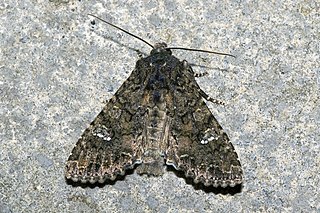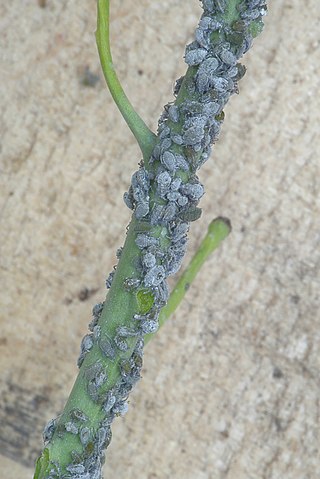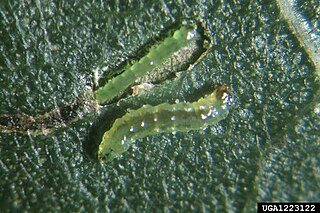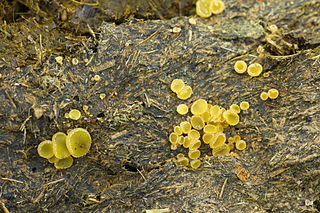
The Pieridae are a large family of butterflies with about 76 genera containing about 1,100 species, mostly from tropical Africa and tropical Asia with some varieties in the more northern regions of North America and Eurasia. Most pierid butterflies are white, yellow, or orange in coloration, often with black spots. The pigments that give the distinct coloring to these butterflies are derived from waste products in the body and are a characteristic of this family. The family was created by William John Swainson in 1820.

Pieris brassicae, the large white, also called cabbage butterfly, cabbage white, cabbage moth (erroneously), or in India the large cabbage white, is a butterfly in the family Pieridae. It is a close relative of the small white, Pieris rapae.

The cabbage moth is primarily known as a pest that is responsible for severe crop damage of a wide variety of plant species. The common name, cabbage moth, is a misnomer as the species feeds on many fruits, vegetables, and crops in the genus Brassica. Other notable host plants include tobacco, sunflower, and tomato, making this pest species particularly economically damaging.

Clubroot is a common disease of cabbages, broccoli, cauliflower, Brussels sprouts, radishes, turnips, stocks, wallflowers and other plants of the family Brassicaceae (Cruciferae). It is caused by Plasmodiophora brassicae, which was once considered a slime mold but is now put in the group Phytomyxea. It is the first phytomyxean for which the genome has been sequenced. It has as many as thirteen races. Gall formation or distortion takes place on latent roots and gives the shape of a club or spindle. In the cabbage such attacks on the roots cause undeveloped heads or a failure to head at all, followed often by decline in vigor or by death. It is an important disease, affecting an estimated 10% of the total cultured area worldwide.

Hyaloperonospora brassicae, in the family Peronosporaceae, is a plant pathogen. It causes downy mildew of species of Brassica, Raphanus, Sinapis and probably other genera within the Brassicaceae. In the past, the cause of downy mildew in any plant in the family Brassicaceae was considered to be a single species Peronospora parasitica. However, this has recently been shown to be a complex of species with narrower host ranges, now classified in the genus Hyaloperonospora, for example Hyaloperonospora parasitica on the weed Capsella bursa-pastoris. From the perspective of plant pathology, Hyaloperonospora brassicae is now the name of the most important pathogen in this complex, attacking the major agricultural and horticultural Brassica species. Other significant Brassicaceous hosts are attacked by different species in the complex, e.g. horseradish by Hyaloperonospora cochleariae, wallflower by Hyaloperonospora cheiranthi.

Alternaria brassicae is a plant pathogen able to infect most Brassica species including important crops such as broccoli, cabbage and oil seed rape. It causes damping off if infection occurs in younger plants and less severe leaf spot symptoms on infections of older plants.

The Madeiran large white is a subspecies of the large white butterfly, endemic to Madeira. It was described by the English entomologist, Arthur Gardiner Butler in 1886.

Brevicoryne brassicae, commonly known as the cabbage aphid or cabbage aphis, is a destructive aphid native to Europe that is now found in many other areas of the world. The aphids feed on many varieties of produce, including cabbage, broccoli (especially), Brussels sprouts, cauliflower and many other members of the genus Brassica, but do not feed on plants outside of the family Brassicaceae. The insects entirely avoid plants other than those of Brassicaceae; even though thousands may be eating broccoli near strawberries, the strawberries will be left untouched.

The serpentine leaf miner is the larva of a fly, Liriomyza brassicae, in the family Agromyzidae, the leaf miner flies. It mines wild and cultivated plants, such as cabbage, broccoli, cauliflower and Chinese broccoli.

The Ascobolaceae are a family of fungi in the order Pezizales. A 2008 estimate places 6 genera and 129 species in the family.

Ascobolus is a genus of fungi in the Ascobolaceae family. The genus has a widespread distribution, and contains an estimated 61 species, most of which are coprophilous. The genus was circumscribed by Christian Hendrik Persoon in 1796.

Ascobolus carbonarius is a species of apothecial fungus belonging to the family Ascobolaceae.

Ascobolus denudatus is a species of apothecial fungus belonging to the family Ascobolaceae.
Ascobolus stercorarius is a species of apothecial fungus belonging to the family Ascobolaceae.

Cotesia glomerata, the white butterfly parasite, is a small parasitoid wasp belonging to family Braconidae. It was described by Carl Linnaeus in his 1758 publication 10th edition of Systema Naturae.
A. brassicae may refer to:
Trichogramma brassicae is a species of parasitoid wasps from the Trichogrammatidae family. It mainly parasitizes Lepidopteran hosts in agricultural fields. They are entomaphagous parasitoids that deposit their own eggs inside the host's eggs, consuming the host egg material and emerging upon full development. They are a common biological control species that have been used commercially since the late 1970s. Inundative releases of T. brassicae, recently, can be done by means of drones and integrated control with Bacillus thuringiensis subsp. kurstaki were demonstrated effective as chemical insecticide treatments and of course without negative environmental side effects.

Pterobilin also called biliverdin IXγ in the Fischer nomenclature, is a blue bile pigment found in Nessaea spp., Graphium agamemnon, G. antiphates, G. doson, and G. sarpedon. It is one of only a few blue pigments found in any animal species, as most animals use iridescence to create blue coloration. Other blue pigments of animal origin include phorcabilin, used by other butterflies in Graphium and Papilio, and sarpedobilin, which is used by Graphium sarpedon.
Ascobolus immersus is a species of fungus belonging to the family Ascobolaceae.
Ascobolus brantophilus is a species of coprophilous fungus in the family Ascobolaceae. It grows on goose droppings.













